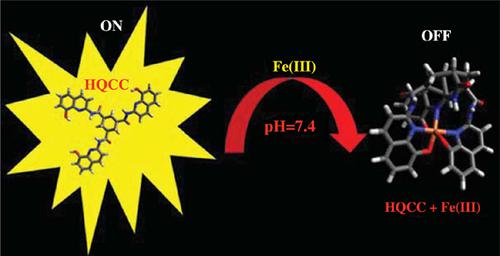Current Analytical Chemistry ( IF 1.7 ) Pub Date : 2020-07-31 , DOI: 10.2174/1573411015666190314154126 Vijay Dangi 1 , Minati Baral 1 , B.K. Kanungo 2

|
Background: Iron is an essential transition metal which is indispensable for life processes like oxygen transport and metabolism, electron transfer etc. However, misregulated iron is responsible for disease like anemia, hemochromatosis, Alzheimer’s and Parkinson’s disease. In order to encounter these diseases, a better understanding is needed of its role in misregulation. Fluorescent iron sensors could help provide this information. The new chemosensor developed by linking a cyclohexane unit with three 8-hydroxyquinoline provides selective detection of iron in numerous biological and environmental samples.
Methods: The Uv-visible and fluorescence spectroscopy in combination with pH measurements will mainly be used for the study. Theoretical studies at DFT level will be used to validate the method and explain the theory behind the experiments.
Results: The study of electronic spectra of the chelator, HQCC, reveals the appearance of a band at 262 nm along with a weak band at 335 nm due to π- π* and n- π* transitions respectively. Upon excitation with 335 nm, the ligand fluoresces at 388 nm wavelength. The intensity of the emission was affected in presence of metal ions, with maximum deviation for Fe(III). Selectivity studies showed that Fe(III) is more selective as compared to the biologically relevant metal ions viz., Al(III), Fe(III), Cr(III), Co(II), Fe(II), Ni(II), Zn(II), Cu(II), Mn(II) and Pb(II). pH dependent studies implied that the fluorescence intensity was highest at pH ~8.0, whereas maximum quenching for iron-HQCC system was observed at pH 7.4. The binding studies from the B-H plot confirms the formation of 1:1 complex with association constant of 5.95 × 106. The results obtained from experiments were in agreement with that obtained from the DFT and TD-DFT studies.
Conclusion: A novel tripodal chelator based on 8-hydroxyquinoline and symmetric cyclohexane scaffold was successfully developed. In addition to the excellence of the ligand to be employed as a promising sensitive fluorescent probe for easy detection of Fe3+ions at the physiological pH with very low concentration (7.5 x 10-5 molL-1), the new ligand can be used as an OFF-ON-OFF pH sensor. Fe(III) encapsulation along with 1:1 ML-complexation formation have been established. Theoretical studies confirm a d-PET mechanism for the fluorescence quenching. DFT studies revealed that the neutral form of the ligand is less reactive than its protonated or the deprotonated form.
中文翻译:

基于环己烷的三脚架分子器件的开发研究
背景:铁是一种必需的过渡金属,对于生命过程如氧气运输和代谢,电子转移等是必不可少的。然而,铁的调节失调可导致诸如贫血,血色素沉着症,阿尔茨海默氏病和帕金森氏病等疾病。为了遇到这些疾病,需要更好地了解其在调节失调中的作用。荧光铁传感器可以帮助提供此信息。通过将环己烷单元与三个8-羟基喹啉连接而开发的新型化学传感器可选择性检测多种生物和环境样品中的铁。
方法:紫外可见光谱和荧光光谱结合pH测量将主要用于研究。DFT级别的理论研究将用于验证该方法并解释实验背后的理论。
结果:对螯合剂HQCC的电子光谱的研究表明,由于π-π*和n-π*跃迁,出现了262 nm的谱带和335 nm的弱谱带。在以335 nm激发后,配体在388 nm波长发出荧光。在金属离子的存在下,发射强度受到影响,Fe(III)的偏差最大。选择性研究表明,与生物相关的金属离子相比,Fe(III)具有更高的选择性,即Al(III),Fe(III),Cr(III),Co(II),Fe(II),Ni(II ),Zn(II),Cu(II),Mn(II)和Pb(II)。pH依赖性研究表明,荧光强度在pH约8.0时最高,而铁HQCC系统在pH 7.4时可达到最大猝灭。BH图的结合研究证实了1:1络合物的形成,缔合常数为5.95×106。
结论:成功开发了一种基于8-羟基喹啉和对称环己烷支架的三脚架螯合剂。除了出色的配体用作有希望的灵敏荧光探针外,它还可以在生理pH值下以极低的浓度(7.5 x 10-5 molL-1)轻松检测Fe3 +离子,新配体也可以用作pH值开关。Fe(III)封装以及1:1 ML络合物的形成已经建立。理论研究证实了荧光猝灭的d-PET机制。DFT研究表明,配体的中性形式与其质子化形式或去质子化形式相比,反应性较低。











































 京公网安备 11010802027423号
京公网安备 11010802027423号